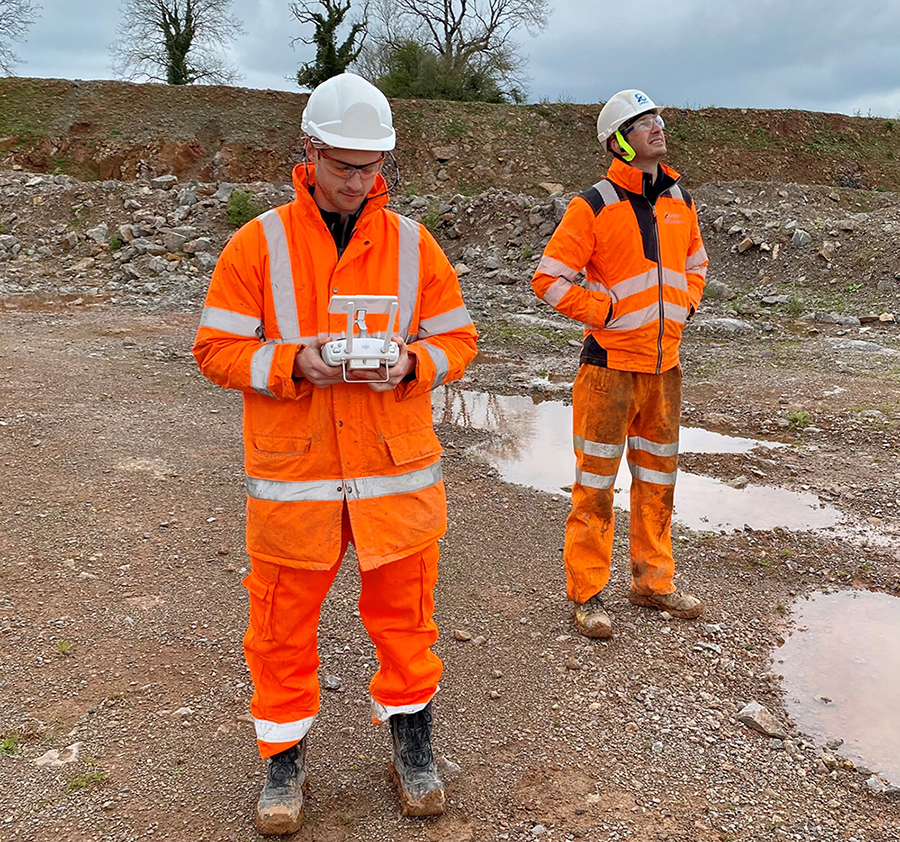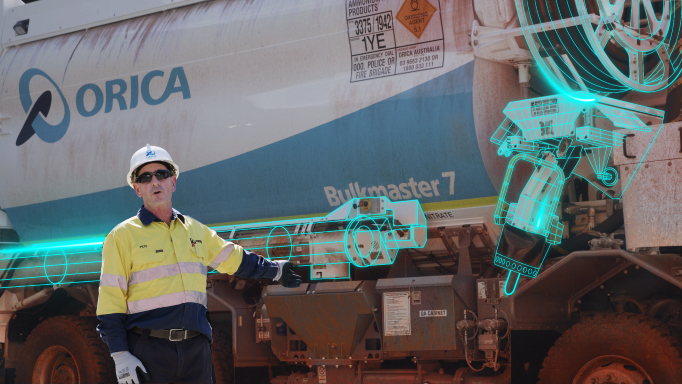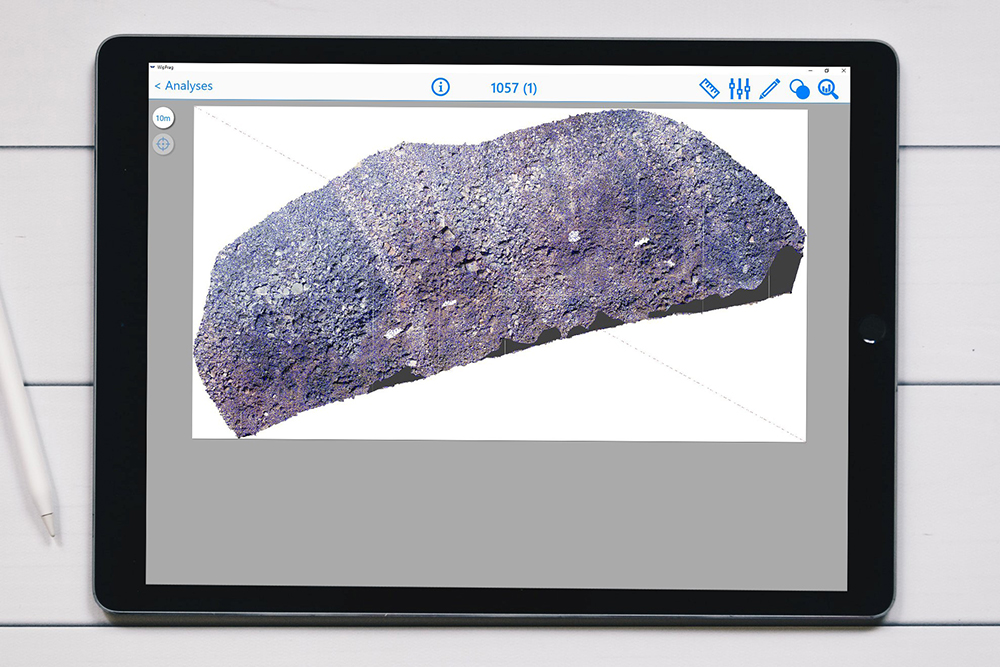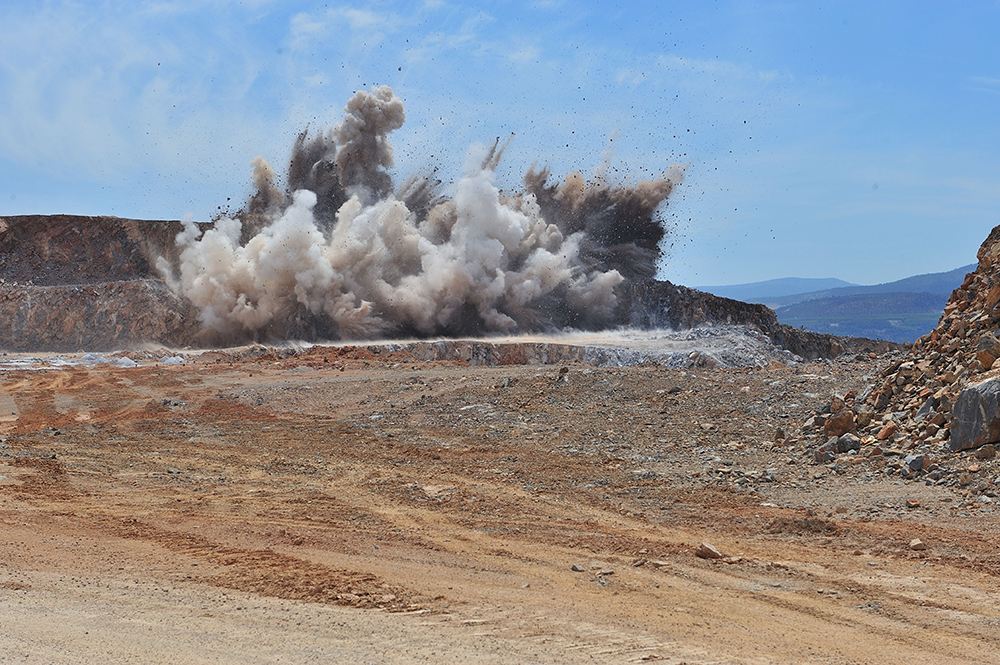
A team of blasting experts in the UK now has a powerful new tool in its arsenal. Following recent training, the specialists from Orica are now utilising drone technology as part of the blasting process. Orica has already been providing solutions to other regions of the world across a broad spectrum of industries including quarrying, utilising drone technology in conjunction with its digital technology for some time.
Stephen Barnett, senior specialist engineer at Orica, says this previous experience means the company is well placed to bring that knowledge into the UK: “We are looking forward to passing the benefits onto our customers across all the industries we supply.”
Orica says that, when it comes to blasting with explosives, getting the right information is everything. With drones now at their disposal, real-time data will provide accurate profiles of quarry faces, which can be imported into Orica’s own advanced blast-design software, SHOTPlus.
By partnering with Propelleraero and using the latest real-time kinetic equipment and technology, Orica says it can now deliver an end-to-end solution for any quarry (in addition to oil and gas, or construction site) including blast design, short-term blast block planning for quarries, videography, stockpile surveys and reports, excavated volumes reconciliation, and fragmentation analysis.
These efficiencies are specifically driven by the usage of drones, and the usable data that is captured. Orica says that using the profiles of quarry faces, accurate measurements through orthophotos, digital elevation models, and textured 3D models, means that a complete picture of the worksite is safely achieved. All these data outputs are used to help site planning and earthwork logistics, before and after each blast.
Training with Consortiq, the Orica blasting team achieved UK certifications in both General Visual Line of Certificate (GVC) and A2 Certificate of Competency (A2CofC). With these qualifications in hand, this regulated training bolsters its capabilities within the global market. The team of specialists chosen for this project come from mixed backgrounds – which Orica says is crucial for this industry. Each one combines their own area of expertise to develop the right solution for the client. Comprised of an explosives engineer, senior specialist engineer, and a digital product lead, those selected and trained are now poised to lead this innovative process throughout the UK market.

Training with Consortiq enables the team to capture powerful data through new means, all while improving efficiencies. Previously, traditional methods took far longer, requiring multiple visits to each site. And in situations like these, time is money.
Lee Barfoot, Consortiq’s commercial manager in the UK, states: “It’s been fantastic to work with Orica UK! Within just a few days they have added a new capability that Orica UK can now use with their clients, in-turn, adding significant value to their product portfolio.”
Consortiq says that, as drones prove themselves an invaluable solution across countless industries, the future is limitless.
“Whether it is a 3D scan, a digital twin, asset allocation, or progress information, drones offer unique solutions to keep your project running smooth,” the company states. “The economic benefits of the technology are simply too beneficial to pass up.”
Orica also recently launched its latest 4D bulk explosives technology at MINExpo in Las Vegas. The system enables the real-time tailoring of explosives energy to geology across a blast, delivering improvements in fragmentation, on bench productivity and an overall reduction in drill and blast costs.
The company says the 4D technology will enable its customers to seamlessly match a greater range of explosives energy across a mine’s geology and target specific blast outcomes in real time.
“By combining emulsion blended with ammonium nitrate porous prills, 4D supports both pumped and augered loading methods across dry, wet and dewatered hole conditions,” Orica states. “An outcome of this unique capability is greater on bench productivity by Orica’s fleet of 4D-enabled mobile manufacturing units (MMU), without the need to change raw materials in the MMU.”
The company says the technology will be applied across its suite of bulk systems including quarrying in the future.
Alternative rock-breaking technology provider AutoStem Technology has launched Generation 3, which it states is an environmentally friendly disruptive technology and “the world’s safest alternative to and replacement of conventional explosives”.
AutoStem says its rock-breaking cartridges are supplied to quarries, mines, and civil construction and demolition sites globally.
The company adds that its flexible product range overcomes and resolves several challenges when compared to conventional explosives.
Traditional conventional explosives are divided into two categories, high and low explosives. AutoStem says its rock-breaking system combines the best of both categories into a third-category explosive product to be used in both primary and secondary blasting applications, selective sensitive or restricted areas, in both civil and mining applications or groundwater and aquatic environments.
The company states: “The innovation of AutoStem is achieved by combining the benefits of delivering high energy to rock with a power factor greater than conventional high explosives though with the slower burn speed of low explosives. The benefits achieved include, although are not limited to, all-around safety improvements, the avoidance of harmful shockwave consequences and vibration effects, flying debris, and toxic contaminants.”
AutoStem adds that its products are non-detonating, meaning that the product action is that of deflagration and shearing of rock rather than the conventional counterpart product which detonates and pulverises rock. AutoStem says that, in effect, its product does not amount to overbreak and with low vibration characteristics it protects surrounding rock and ground strata, adding the benefit of better blasting control, and fragmentation.
No explosive accessories are required, which the company says means the use of detonators and detonator transportation, storage or handling is avoided. AutoStem products are also dual self-stemming, therefore there is no need for the blasters to add gravel, stemming, or tamping material. This is designed to improve efficiencies in safety, time, and cost. All AutoStem cartridges are categorised as Gas Generator P2 - 1.4s which enables AutoStem Technology to transport and store its products internationally with fewer restrictions.
When transported, AutoStem does not require a security escort as the company says the product cannot self-ignite due to the novel safety-switch technology and cannot therefore be used for destructive or malicious intent.
The company states: “The AutoStem product is so safe that it can be transported by air courier and stores safely with the added benefit of a longer shelf life than conventional explosives products. Given the characteristics of conventional explosives and the impact on global security, safety, and environment, the AutoStem innovation, in contrast, has inherent safety and impact control mechanisms built into the product features and characteristics that are deemed generic in safety, health, environment and risk, as well as corporate ESR planning and compliance management.”

AutoStem says its product is internationally accredited by all regulatory bodies for use in hard-material excavations, ground, or concrete works, and structure demolitions and can be used in proximity of communities or infrastructure, above or below ground, and underwater without causing contamination or damage.
Blasting-technology provider EPC-UK has added digital expertise and progressive ‘blasting’ techniques to its crushing capabilities.
The company says that, as demand to optimise overall site performance within quarrying operations gathers pace on a global level, implementation of the most effective crushing market technologies continues to grow, driving demand for the research and delivery of safe, proven solutions.
Explaining the technologies and benefits of its digitalised route to crushing optimisation, EPC’s commercial manager Ryan Ward and explosives engineer Dr. Liam Bermingham have detailed the team’s advanced approach to improving crushing technologies using methods that are becoming increasingly pertinent to the industry’s wider, ‘future-ready’ development.
“A truly effective quarrying operation is reliant on advanced crushing technology to enhance its overall site performance,” Ward explains. “However, to optimise ‘crushing’, progressive ‘blasting’ techniques have become essential.”
He says EPC-UK’s metrics team has developed and delivered targeted blast fragmentation using dynamic fragmentation analysis - enabled by utilising drone survey modelling of post-blast results.
“We are fragmentation and blast-performance specialists,” Ward continues, “and prioritise the need to look at projects in their site-wide capacity. We also introduce systems that become increasingly important further downstream, such as static fragmentation tools for use at the crusher house as dumpers load in, or along the conveyor system at the pre-primary crusher stage.”
To achieve improved ‘crushing’ operations, EPC-UK applies technologies - including those from WIPFRAG and Motion Metrics - that are capable of providing the static systems required.
An automated image-based granulometry system that uses digital analysis of rock photographs and video images, WIPFRAG is a quick and accurate software solution designed to provide the size distribution measurements essential to managing fragmented rock.
The EPC metrics team can use the software solution to provide particle size analysis for shovels, conveyor belts and haul trucks in a portable format that neither interrupts production nor requires reference-scaling objects.
“By utilising both static and dynamic crushing and fragmentation measurement tools, we can realise totally accurate data on the performance of blasting and crushing, and subsequently deliver customers ‘valuable and desired end-products’ in terms of sizing in the most cost-effective way,” Ryan adds.
He adds that EPC-UK collaborates with quarry operators to extract the information from both static and dynamic tools to produce and help users understand real trend performance and data. Analysed collectively, the data is said to improve blasting fragmentation the ‘Digital Quarrying Way’, supporting downstream performance, whilst saving money and improving productivity.
EPC-UK says that digital quarrying techniques are now leading the way in advanced operational practice, and adds that its metrics team has realised its goal of developing a safer, more effective quarry through advanced digital means.
Bermingham states that the company’s cutting-edge and safety-focused digital quarrying evolution combines the use of drone-sourced information with critical software application analysis. “Combined, the technologies enable total measurement accuracy and provide both performance data analysis and recordings to benefit all elements of the quarrying operation,” he adds.
“From the drill and blast to the load and haul, followed by the crushing and screening process, our digitalised technologies are safely equipping quarrying teams with recordable KPIs that can be monitored and reviewed – noticeably improving blast performance and delivering quantifiable results.”
By analysing data in conjunction with KPIs recorded throughout various stages of the quarrying process, EPC-UK says operators can make the correct decisions for future blast designs.
All key information is inputted into EPC-UK’s online cloud-based database, ‘Explore’, from where engineers and quarry operatives can look at and analyse all data elements together. The company says the consolidated information helps improve fragmentation and betters loading times at the face.
Decreases in fuel usage of face excavators or front-end loaders indicate an improvement in fragmentation. Ward says: “By ensuring that technological advancements support our existing expertise, we can continue to develop productive, safe quarrying environments as we strengthen relationships and confirm our market-leading position as an industry innovator, transparent partner and proven safety ambassador.”
Extractives-industry training provider MP Skills has announced the latest addition to its course catalogue.
Accredited by MP Awards, the ‘Blasting for Non-Blasting Managers’ course has initially been designed to accommodate the demand for training in Northern Ireland but will be available to the rest of the UK, in the not-too-distant future.
Spread across four days, the classroom-based programme will benefit supervisors or managers, who are responsible for blasting operations on site, but who are not appointed as the explosives supervisor under the Quarry Regulations 1999, Reg 25.1(b).
The aim of the course is to provide learners with sufficient knowledge and understanding of blasting operations which will, in turn, strengthen the ability to manage the undertaking of such, on site.
It will also give delegates the level of understanding required to successfully complete the knowledge assessment criteria for the MPQC Level 6 Award in Managing Quarry Drilling and Blasting Vocational Qualification (VQ).
Attendees can expect to cover content inclusive of use of explosives at quarries in Northern Ireland.
Learning will be delivered through short lectures, demonstrations, group discussions, case studies and practical instruction. Upon successful course completion, attendees will receive an MPQC Certificate of training.
Neil Peacock, MP Skills general manager, said: “It’s an exciting time at MP Skills, we’re thrilled to be able to offer this course to our Northern Irish counterparts, who have identified the need for this type of training, and see it as investment in strengthening operational competencies, across their workforce and indeed their sites.”

Australia-based Maptek has released its new Vulcan GeologyCore solution, which is based on the premise of making geological modelling simple for sectors such as quarrying and mining.
Vulcan GeologyCore is designed to meet the need for an intuitive geological modelling workflow that handles automatic validation and chart creation, providing geologists with greater confidence around their domain and modelling decisions.
The dynamic interface and streamlined workflow make it easy to test different domaining scenarios and view live statistics, before proceeding to the preferred modelling method. Customers can choose from implicit or vein modelling in Vulcan or can easily access the machine-learning engine in DomainMCF.
“As a geologist, I sum up the impact of Vulcan GeologyCore from the belief that our time is better spent making decisions about geology, rather than in specification setup,” said Richard Jackson, Vulcan geology team lead at Maptek.
Vulcan GeologyCore harnesses interactive drillhole visualisation, lithology targeting and modelling algorithms for narrow vein, disseminated or stratigraphic deposits.
Maptek says that a significant benefit of this new approach is the streamlined data management. The process sets up project data in a reliable, validated way, removing manual data validation and manipulation.








